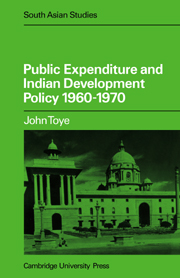Book contents
- Frontmatter
- Contents
- List of Tables
- Preface
- List of Abbreviations
- Introduction
- PART ONE GENERAL
- PART TWO EMPIRICAL EVIDENCE
- 4 The fiscal performance of the public sector
- 5 Public expenditure and the industrial recession
- 6 The degree of public expenditure centralization
- 7 The growth of state governments' spending
- 8 Public investment, public saving and the state governments
- PART THREE CONCLUSIONS
- APPENDICES
- List of works cited
- Index
8 - Public investment, public saving and the state governments
from PART TWO - EMPIRICAL EVIDENCE
Published online by Cambridge University Press: 09 January 2010
- Frontmatter
- Contents
- List of Tables
- Preface
- List of Abbreviations
- Introduction
- PART ONE GENERAL
- PART TWO EMPIRICAL EVIDENCE
- 4 The fiscal performance of the public sector
- 5 Public expenditure and the industrial recession
- 6 The degree of public expenditure centralization
- 7 The growth of state governments' spending
- 8 Public investment, public saving and the state governments
- PART THREE CONCLUSIONS
- APPENDICES
- List of works cited
- Index
Summary
Overall trends in public investment and public saving during the period 1960–70 were surveyed in Chapter 4. It became clear that, at least from the end of the Third Five-Year Plan, public sector investment fell both as a percentage of net domestic product, and of total gross fixed capital formation. At the same time, public saving showed an absolute decline, despite quickening inflation, and therefore (until 1969/70) served as a dwindling source of finance for a public sector investment programme that was virtually stagnant. The purpose of this chapter is to probe behind the aggregate trends, in order to see how the activities of the different types of governmental spending agency contributed to them. The approach follows that adopted in Chapter 5 in relation to total public expenditure.That is, we begin by examining changes in the degree of centralization of public investment and saving, treating the state governments as a unified group that can be contrasted with the central government. Thereafter an attempt is made to give estimates of inter-state differences in the rate of growth of their investment and saving, and to find statistical regularities that might point towards an explanation of these differences.
PUBLIC INVESTMENT CENTRALIZATION
The total gross capital formation done by the public sector can be disaggregated to show the shares of the central government, the state governments, local authorities (together defined as the ‘public authorities’) and the share of the non-departmental enterprises (i.e. government companies and statutory corporations).
- Type
- Chapter
- Information
- Public Expenditure and Indian Development Policy 1960–70 , pp. 176 - 212Publisher: Cambridge University PressPrint publication year: 1981



